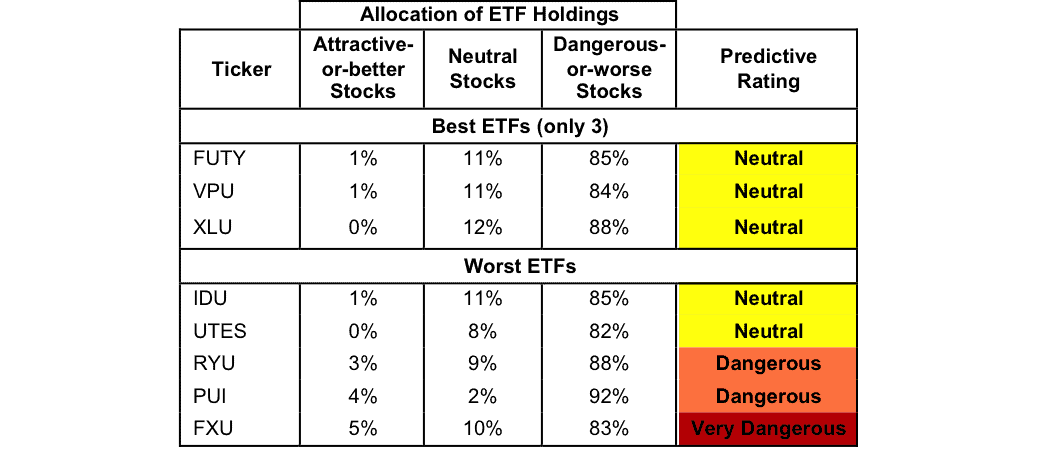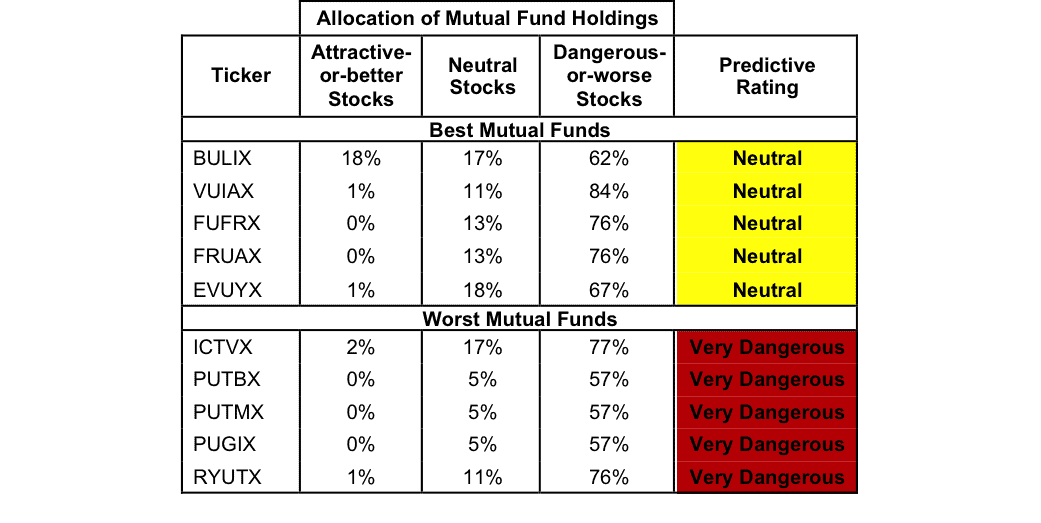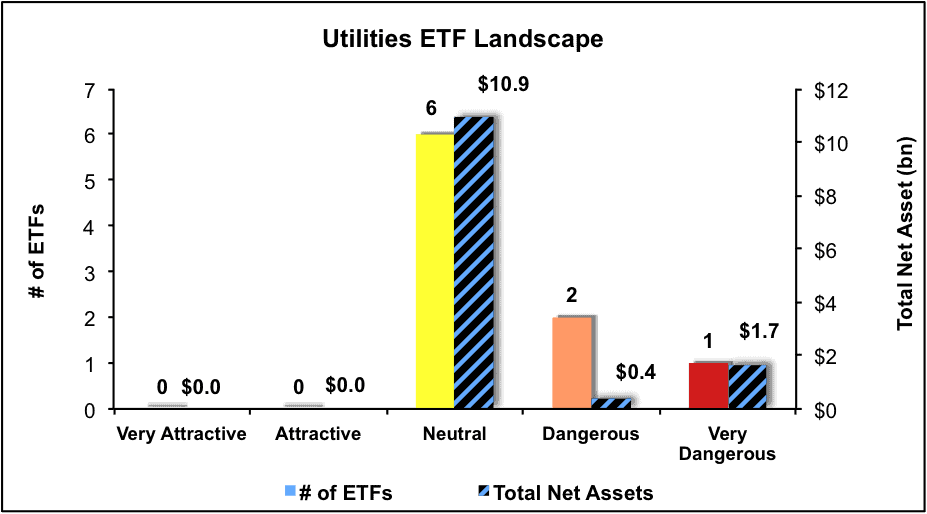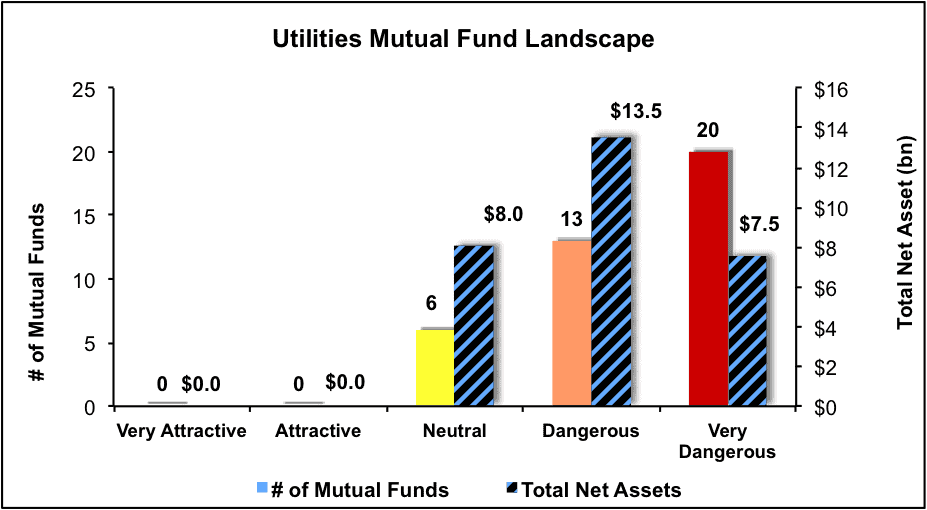Sector Analysis 4Q16
The Utilities sector ranks eighth out of the ten sectors as detailed in our 4Q16 Sector Ratings for ETFs and Mutual Funds report. Last quarter, the Utilities sector ranked last. It gets our Dangerous rating, which is based on an aggregation of ratings of nine ETFs and 39 mutual funds in the Utilities sector as of October 19, 2016. See a recap of our 3Q16 Sector Ratings here.
Figure 1 ranks from best to worst the eight Utilities ETFs that meet our liquidity standards and Figure 2 shows the five best and worst rated Utilities mutual funds. Not all Utilities sector ETFs and mutual funds are created the same. The number of holdings varies widely (from 20 to 249). This variation creates drastically different investment implications and, therefore, ratings.
Investors should not buy any Utilities ETFs or mutual funds because none get an Attractive-or-better rating. If you must have exposure to this sector, you should buy a basket of Attractive-or-better rated stocks and avoid paying undeserved fund fees. Active management has a long history of not paying off.
Figure 1: ETFs with the Best & Worst Ratings – Top 5
* Best ETFs exclude ETFs with TNAs less than $100 million for inadequate liquidity.
Sources: New Constructs, LLC and company filings
PowerShares S&P SmallCap Utilities (PSCU) is excluded from Figure 1 because its total net assets (TNA) are below $100 million and do not meet our liquidity minimums.
Figure 2: Mutual Funds with the Best & Worst Ratings – Top 5
* Best mutual funds exclude funds with TNAs less than $100 million for inadequate liquidity.
Sources: New Constructs, LLC and company filings
Fidelity MSCI Utilities Index ETF (FUTY) is the top-rated Utilities ETF and American Century Utilities Fund (BULIX) is the top-rated Utilities mutual fund. Both earn a Neutral rating.
First Trust Utilities Fund (FXU) is the worst rated Utilities ETF and Rydex Utilities Fund (RYUTX) is the worst rated Utilities mutual fund. Both earn a Very Dangerous rating.
75 stocks of the 3000+ we cover are classified as Utilities stocks.
UGI Corporation (UGI: $45/share) is one of our favorite stocks held by Utilities ETFs and mutual funds and earns an Attractive rating. Over the past decade, UGI has grown after-tax profit (NOPAT) by 7% compounded annually to $610 million in 2015 and even further, to $773 million over the last twelve months (TTM). The company’s return on invested capital (ROIC) has improved from 4% in 2012 to 8% TTM. Despite the improvement in underlying fundamentals, UGI remains undervalued. At its current price of $45/share, UGI has a price-to-economic book value (PEBV) ratio of 0.9. This ratio means that the market expects UGI’s NOPAT to permanently decline by 10%. This expectation seems rather pessimistic given that UGI has grown NOPAT by 8% compounded annually over the past decade. If UGI can grow NOPAT by 7% compounded annually for the next decade, the stock is worth $56/share today – a 24% upside.
Chesapeake Utilities Corp (CPK: $61/share) is one of our least favorite stocks held by Utilities ETFs and mutual funds and earns a Very Dangerous rating. CPK has generated negative economic earnings in every year of our model (dates back to 1998) and economic earnings have declined from -$8 million in 2005 to -$28 million TTM. The company’s ROIC has fallen from 6% in 2010 to 5% TTM. Despite the shareholder value destruction, CPK is still priced for significant profit growth. To justify its current price of $61/share, CPK must grow NOPAT by 10% compounded annually over the next 13 years. This expectation seems overly optimistic given CPK’s inability to generate true profits over the past decade.
Figures 3 and 4 show the rating landscape of all Utilities ETFs and mutual funds.
Figure 3: Separating the Best ETFs From the Worst ETFs
Sources: New Constructs, LLC and company filings
Figure 4: Separating the Best Mutual Funds From the Worst Mutual Funds
Sources: New Constructs, LLC and company filings
This article originally published here on October 19, 2016.
Disclosure: David Trainer, Kyle Martone, and Kyle Guske II receive no compensation to write about any specific stock, sector or theme.
Click here to download a PDF of this report.
Photo Credit: William Mewes (Flickr)




